Last Updated on April 13, 2025 by Kittredge Cherry
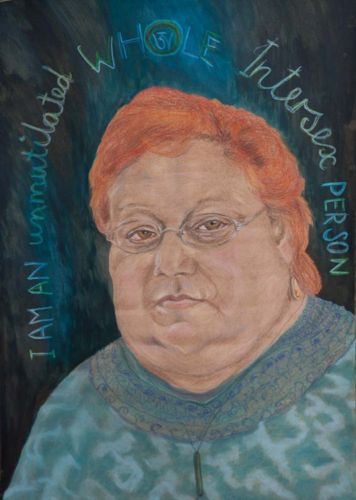
Sally Gross was an intersex South African anti-apartheid activist who became a Catholic priest — but was stripped of clergy status after revealing that she identified as female in the 1990s. She became an intersex activist, winning legal recognition of intersex for the first time in the world.
[Coming soon on Aug. 15, 2025: New book “Body Problems: What Intersex Priest Sally Gross Teaches Us About Embodiment, Justice, and Belonging” by M. Wolff. Published by Duke University Press.]
Gross helped change national laws and mentored intersex activists worldwide. Her writings on intersex theology continue to be examined and developed in books by contemporary queer theologians. As a priest, Gross taught moral theology in the elite world of Oxford and Cambridge. Later she turned to Quaker and Buddhist spirituality. Vivid personal memories of Gross are shared by her queer clergy colleague Michael Worsnip, who recalls her as “incandescent” and “a legend,” affirming that “You certainly could not ignore her.”
It is especially appropriate to remember Sally Gross during the “Fourteen Days of Intersex” between Intersex Awareness Day (Oct. 26) and Intersex Day of Remembrance (Nov. 8), also known as Intersex Solidarity Day.
Gross also identified as asexual or “one of nature’s celibates.” Her extraordinary life mixed Jewish and Christian faiths and citizenship in South Africa, Israel and the United Kingdom.
Changes in her personal life happened in parallel with similar political shifts in her native country. She moved from an imposed male identity to her true intersex self while South Africa made the transition from white-minority rule to a multi-racial democracy.
Born intersex and classified male
Sally Gross (Aug. 22, 1953 – Feb. 14, 2014) was born to an Orthodox Jewish family in suburban Cape Town. Parents and medical staff were alarmed because there was no easy answer to the standard question of whether the newborn was a boy or a girl. “Anatomically my body is exceedingly ambiguous, and was clearly so when I was born,” Gross explained in the 2009 article “The Journey from Selwyn to Sally.” It was published by the Witness, the oldest continuously publishing newspaper in South Africa, and remains the most extensive online article her.
The baby was spared the genital reshaping surgery that became standard practice a few years later in an effort to make all children fit the gender binary. The intersex infant was classified male, given the masculine name Selwyn, and raised as a boy.
After an Orthodox Jewish education, including a year of traditional rabbinical training at a yeshiva in England, Gross was attracted to Catholicism. Gross ended up leaving Judaism because Christians were doing more to end apartheid, a system of racial segregation. Christian theology also did more to help Gross with the stigma and resulting stress caused by having an intersex condition. As with gender, Gross’ approach to faith was not a strict either/or binary. She continued to honor her Jewish heritage.
Christianity helped with confusion and pain
Gross discussed how Christianity helped her as an intersex person with the Witness:
“The image of the cross seemed to be an icon of all manner of confusion and suffering. The Holocaust was there, the horror of apartheid was there, and my own personal confusion and pain — which I could never publicly admit — was there as well. And in the resurrection was a symbol that this was transcended. And at the back of my mind, there would have been an awareness that in Christianity there are strands of tradition in which celibacy is valued and turned to positive use.”
Gross was baptized in 1976. Soon afterward black students led a major uprising in Soweto, motivating the newly baptized Christian to became more involved as an anti-apartheid political activist. Gross left South Africa in 1977 for safety as a political refugee on the advice of colleagues in the African National Congress (ANC), moving to first to Botswana and then to join her parents in Israel. Stripped of South African citizenship, Gross became a citizen of Israel. Exile led to greater involvement with the Dominicans, a major Roman Catholic order.
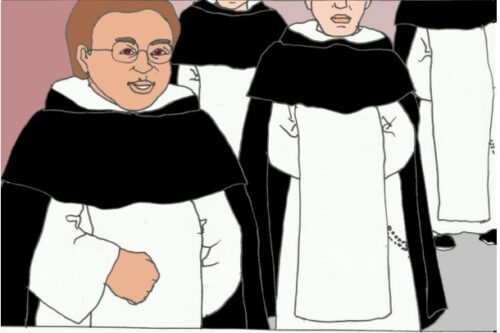
Gross joins the Dominicans in art by Jan Haen, author of “Heavenly Homos, Etc.: Queer Icons from LGBTQ Life, Religion, and History.”
In 1981 Gross was accepted into the novitiate of the Dominican order in Oxford, England, and became a naturalized British citizen. After ordination in 1987, the young priest was honored with important assignments. “Father Selwyn” taught moral theology and ethics at Blackfriars in Oxford, and gave philosophy tutorials at various other colleges of Oxford University. Meanwhile Gross continued to do anti-apartheid activism, serving as a member of the then-banned ANC delegation under Thabo Mbeki, who later became president of South Africa. In 1992 Gross became sub-prior at the Cambridge priority, a Dominican intellectual center founded in 1238.
Gross identifies her intersex condition in adulthood
Apartheid was dismantled in 1990-91, culminating in elections South Africa’s first election open to all races in 1994. Gross’ South African citizenship was restored in 1991 — with a male designation. Gross felt the time had come to address the other major tension in her life: gender.
She consulted a counselor at a transgender organization, who helped helped Gross identify her intersex condition. She underwent extensive medical testing that found that her testosterone levels were midpoint in the female range but less than an eighth of the bottom of the male range. Gross agreed with the suggestion of a “real-life test” living in a female role for a year, even as she resisted pressure from the counselor to fit the transgender model.
The Dominicans grudgingly granted Gross a year’s leave of absence to live as a woman, while forbidding her to tell anyone and insisting that she move to a new place. Gross began living as Sally in Eastbourne on the south coast of England. She knew that women were excluded from Catholic priesthood, but she hoped to continue living in a religious community as a nun, possibly in a mixed community of both sexes.
Church revokes her clergy status over intersex issues
However when Gross informed the church that she was an intersex person who identified as female, they revoked her clergy credentials, annulled her religious vows — and imposed rules that effectively made it impossible for her to even attend any Catholic church.
“It was the biggest trauma of my life, one that was surely life-threatening and dragged on for a long time,” she told the Witness in 2009. Gross was still trying to heal and express this trauma through artistic collaboration at the time of her death four years later.
Even her baptism was questioned. In her 1998 paper “Intersexuality and Scripture,” she wrote that “pious, intelligent, theologically sophisticated but fundamentalistic Christians of my acquaintance’ argued that “like dogs, cats and tins of tuna, I am not the kind of thing which could have been baptised validly.”
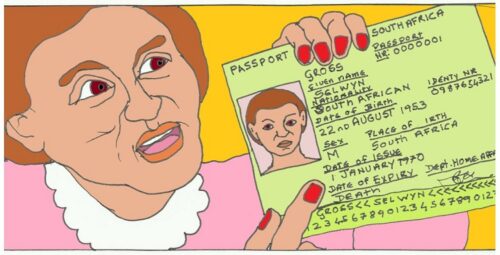
Sally Gross points at the passport that she fought to correct in art by Jan Haen.
Gross ended up staying in Eastbourne several years longer, facing a 15-month legal battle with South African officials to correct her name and gender on her passport. South Africa banned her from returning until the issue was resolved. It was suggested informally that she solve the conflict by submitting to genital “disambiguation” surgery. “I considered this an immoral suggestion – to undergo dangerous and unnecessary surgery as a condition for having a legal identity. I made it clear I would take legal action if this was put to me formally,” Gross told the Witness.
Finally in 1997 officials issued a passport stating that Gross was born female, on the grounds of mis-identification at birth. Gross went on to live in South Africa, where she became an activist for intersex rights. In 2000 she got “intersex” included in the South Africa’s anti-discrimination law — the the first known mention of intersex in any national law. Ten years later founded the community organization Intersex South Africa (ISSA). In that role she recorded a video for the It Gets Better project in 2013.
Gross directed ISSA until her death in February 2014 at age 60. As with other aspects of her identity, the official record differs from her lived experience. Her official date of death is Feb. 14, 2014, which is when her body was discovered, but she was believed to have died on Feb. 11. She fought for intersex rights to the end, even as her health failed. “Sally died alone, in her flat in Cape Town, having been forced to appeal to friends for funds to pay rent and medical bills as her health deteriorated; she was virtually immobile,” the Daily Maverick reported.
Gross has been portrayed by artists
Artists who have portrayed Sally Gross include Gabrielle Le Roux, a South African artist and activist for social justice, and Jan Haen, a Catholic priest and Dutch artist who grew up in South Africa.
Gross was collaborating with her friend Gabrielle Le Roux on a series of portraits in the year before her death. They completed two out of the planned six portraits. Gross did not live long enough to finish the third portrait based on her rejection by the church. The first portrait includes inscriptions such as “Ehyeh asher Ehyeh,” (Canaanite / early Hebrew letters for “I am what I am,” God’s words to Moses from the burning bush.
Gross hand-wrote her own powerful words on the second portrait: “I am an unmutilated, whole Intersex PERSON.” It was included in “Queer and Trans Art-iculations: Collaborative Art for Social Change,” a 2014 portrait exhibition of transgender and intersex Africans at the Wit Museum in Johannesburg.
In a memorial tribute to Gross, Le Roux described how their plans for an artwork about how the church rejected the intersex priest:
“She had decided what she wanted to wear for the third one – a garment that needed to be made specially, akin to what she wore as a Dominican priest but in a strong shade of deep pink. She planned to write in the background about her experience of vicious rejection and victimization by the church when she came out to them as intersex – a massively scarring experience for her. One of her dreams was that she would share her experience with the church in a way that would make them change their policy on intersex people. To this end she recently wrote to the new Pope as she hoped that, with a more humane world view than his predecessors, he might make some significant changes when he heard about the devastating impact on her of their prejudice.”
Gross’ whole extraordinary life, with its many unusual twists and turns, is re-told in graphic-novel format in the forthcoming book “Heavenly LGBTQ+” by Jan Haen, a Dutch artist and Roman Catholic priest in the Redemptorist order. It is the sequel to his 2022 graphic non-fiction book “Heavenly Homos, Etc.: Queer Icons from LGBTQ Life, Religion, and History.” Saints and heroes of the LGBTQ community come alive through bold, cartoon-like artwork in his illustrated books. Short, accessible text lets the pictures tell their stories.

Gross, center, at a 1987 gathering of the African National Congress in art by Jan Haen.
Haen’s storytelling style includes action scenes that are rarely if ever portrayed by artists, such as Gross raising an arm at a multi-racial gathering of the African National Congress. The artist doesn’t recall ever meeting Gross in person when they were both living in South Africa. Like Gross, Haen had to leave the country in the late 1970s under pressure from the apartheid regime.
Theology and philosophy of Sally Gross
Christian theologians have struggled with intersex or so-called “hermaphrodite” people at least since Augustine of Hippo wrote about it. Gross wrote theological papers on intersex that show the erudite brilliance of her mind.
The entire scholarly paper “Intersexuality and Scripture,” written by Sally Gross in 1998, is posted online by Engender.org.
In the paper Gross provides evidence that Adam, the first human being, was intersex. She notes the shift in pronouns in Genesis 1:27: “So God created man [the Hebrew is ‘Adam’] in his own image, in the image of God he created him; male and female he created them.”
Gross reveals that this potentially liberating passage was used against her “to argue that God created all human beings determinately male or determinately female with nothing in-between. At a more personal level, they have also been used to argue that an intersexed person such as me does not satisfy the Biblical criterion of humanity, and indeed even that it follows that I am congenitally unbaptisable and must therefore be said not to have been baptised validly.”
Instead of the rigid duality of male/female, Gross knows firsthand that sex and gender are a spectrum. “To use a rather hackneyed metaphor: we are a rainbow nation, and that rainbow quality, that diversity, is to be seen as a strength rather than as a weakness. And perhaps intersexuality shows also that we are a rainbow species: there is more diversity in physical types than people find it easy to concede,” she told the Witness.
Fourteen Days of Intersex
Intersex Awareness Day (Oct. 26) commemorates the first public demonstration by intersex people in North America. On Oct. 26, 1996, protesters gathered in Boston outside the annual conference of the American Academy of Pediatrics. Organizers had intended to speak at the conference to challenge the assumption that intersex children need cosmetic surgery, but security guards forced them out so they protested with a sign saying, “Hermaphrodites With Attitude.”
 Intersex Day of Remembrance, also known as Intersex Solidarity Day, occurs on Nov. 8 for the birthday of French intersex person Herculine Barbin. Philosopher Michel Foucault published her memoirs in “Herculine Barbin: Being the Recently Discovered Memoirs of a Nineteenth-Century French Hermaphrodite.”
Intersex Day of Remembrance, also known as Intersex Solidarity Day, occurs on Nov. 8 for the birthday of French intersex person Herculine Barbin. Philosopher Michel Foucault published her memoirs in “Herculine Barbin: Being the Recently Discovered Memoirs of a Nineteenth-Century French Hermaphrodite.”
Two intersex-affirming hymns were written by Daniel Charles Damon in 2022 for a worship service observing Intersex Solidarity Day at The Table, an LGBTQIA+ centered faith collective in Nashville, Tennessee. Damon pastors First United Methodist Church in Richmond, California. The hymns are “Intersex People” and “O God, You Share Your Beauty.”
Intersex Awareness Day tends to be celebrated in North America, while Europe emphasizes Intersex Day of Remembrance. Some countries honor both events and the whole period between as “Fourteen Days of Intersex.”
Intersex theology books
A variety of queer theology books discuss the life and theology of Sally Gross, including:
“Religion and Intersex: Perspectives from Science, Law, Culture and Theology” by Stephanie Budwey. Published by Routledge, Aug. 2022.
“Sex and Uncertainty in the Body of Christ: Intersex Conditions and Christian Theology” by Susannah Cornwall, 2010.
“Sex Difference in Christian Theology: Male, Female, and Intersex in the Image of God” by Megan K. DeFranza, 2015.
“Intersex in Christ: Ambiguous Biology and the Gospel” by Jennifer Anne Cox, 2018.
Links related to Sally Gross
“Intersexuality and Scripture” by Sally Gross, 1998 (Engender.org)
Sally Gross: The fight for gender equality loses a giant (Daily Maverick)
Sally Gross (South African History Online)
Intersex links at Q Spirit
Thomas(ine) Hall: Intersex in colonial America
___
Top image credit:
Sally Gross portrait by Gabrielle Le Roux, 2013: “I am an unmutilated, whole Intersex PERSON.”
___
This post is part of the LGBTQ Saints series by Kittredge Cherry. Traditional and alternative saints, people in the Bible, LGBT and queer martyrs, authors, theologians, religious leaders, artists, deities and other figures of special interest to lesbian, gay, bisexual and transgender and queer (LGBTQ) people and our allies are covered.
This article was originally published on Q Spirit on Aug. 1, 2022, was expanded with new material over time and was most recently updated on April 13, 2025.
Copyright © Kittredge Cherry. All rights reserved.
Qspirit.net presents the Jesus in Love Blog on LGBTQ spirituality.

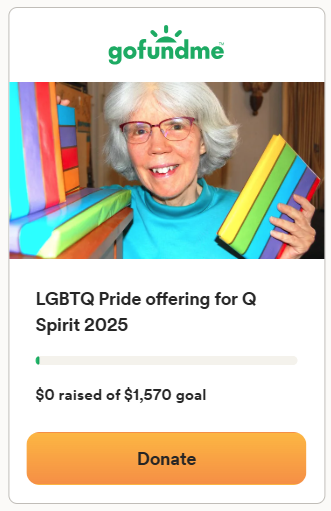
















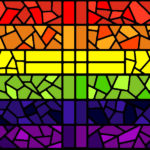

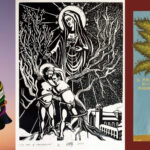
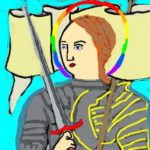
I knew SG at Blackfriars Cambridge and greatly admired the sermons that were delivered having that double insight of full knowledge of the Old Testament combined with the newly learnt New Testament.
Thanks! When I started reading your comment, I thought you were going to say “that double insight of full knowledge of male and female identities.” But Sally had the double insight into the Old and New Testaments too.